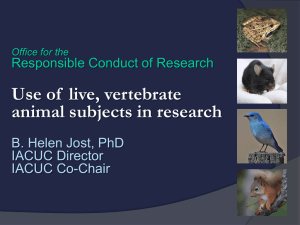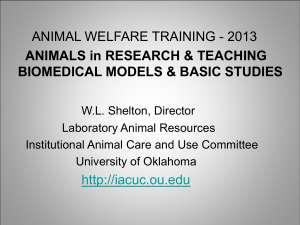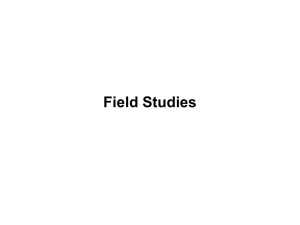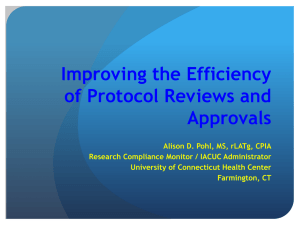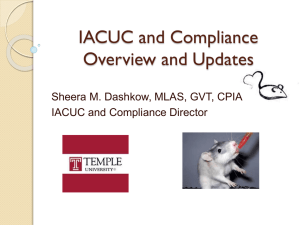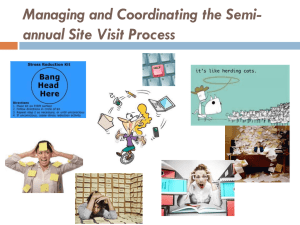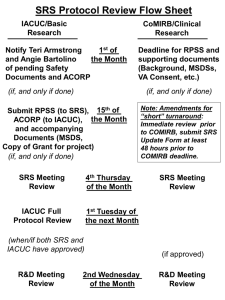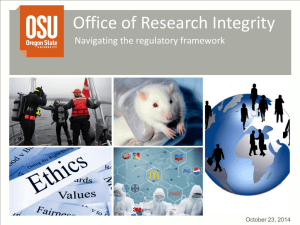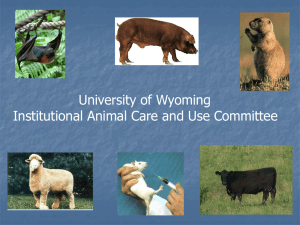ASU: Following IACUC Guidelines
advertisement
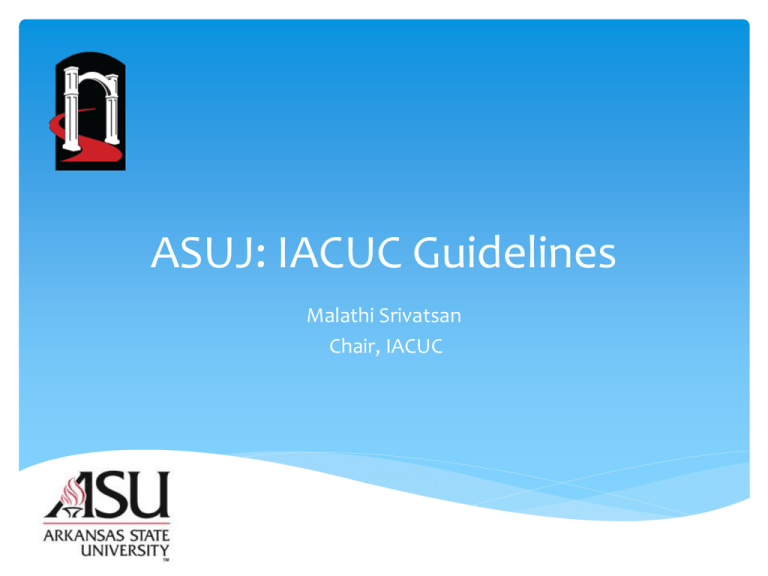
ASUJ: IACUC Guidelines Malathi Srivatsan Chair, IACUC What Does IACUC Stand for? Institutional Animal Care and Use Committee IACUCs are required by….. Federal Law (Animal Welfare Act) Regulations - United States Department of Agriculture (USDA) Policies - Public Health Service (PHS) What are the Functions of IACUC? To assist investigators and instructors in maintaining the institution’s compliance with the Animal Welfare Act and federal animal welfare regulations Review of research and teaching activities involving the use of vertebrate animals Review/monitor welfare of vertebrate animals maintained by the institution (housing and care) Who are concerned with animal welfare? Governmental Agencies - USDA- Animal and Plant Health Inspection Service (APHIS) - Health and Human Services (HHS) Public Health Service (PHS) National Institutes of Health (NIH) Office of Laboratory Animal Welfare (OLAW) Food and Drug Administration (FDA) 4 Who else is concerned with animal welfare? Scientists - Scientists’ Center for Animal Welfare (SCAW) - American Association for Laboratory Animal Science (AALAS) - Association for the Accreditation and Assessment of Laboratory Animal Care (AAALAC, International) - Institute for Laboratory Animal Research (ILAR) - Federation of Animal Science Societies (FASS) 5 Who else is interested? Public Animal-Centric Organizations American Humane Association (AHA) Humane Society of the United States (HSUS) Society for the Prevention of Cruelty to Animals (SPCA) Health Care Consumers (medical treatments, vaccines, cures for disease) Agricultural Operations (Meat and Dairy Producers) Consumers-Public 6 Animal Welfare and Animal Rights USDA, PHS, OLAW and IACUCs are concerned with the safe, appropriate and humane use of animals for agricultural and biomedical research and teaching. Our focus is animal welfare. Many animal rights groups, based on the views of individuals, are opposed to the use of animals for research, education, transportation, recreation, or exhibition, to name a few. 7 What information is available to Public? Under Freedom Of Information Act (FOIA) The following can be requested by the public: USDA Inspection Reports Approved Protocols Minutes of IACUC meetings Assurance Statement Animal Care Program reviews Facility inspection reports 8 Why do Universities need IACUCs? Laws, Regulations, and Policies These committees were established in accordance with the Animal Welfare Act (1966, 1970) and the 1976, 1985, and 1990 AWA Amendments Mice, Rats, and Birds were originally excluded from the act In 1999 a petition was filed with the USDA Secretary of Agriculture to remove this exclusion The Helms amendment to the 2002 Agriculture Bill specifically exempts Mice, Rats and Birds 9 Why do Researchers need IACUC approval? Institutions can establish policies requiring all vertebrate animal use subject to IACUC review and approval. Federal Funding Agencies require IACUC approval of proposals if vertebrate animals are used before releasing their funds. Many journals insist on IACUC approval if vertebrate animals are used in the study to be published. 10 What can happen if an institution is out of compliance with federal regulations? Federal funding (USDA, NIH, PHS, NSF etc.) could be withdrawn from an institution found to be noncompliant with the AWA and federal regulations. The Animal Welfare Assurance Statement that ASU has on file with OLAW assures the federal government that ASU will comply with the AWA and all federal regulations. Also institution can incur heavy fines including in rare instances, prison sentences. 11 Oversight of Animal Use AWA administered by USDA-APHIS http://www.aphis.usda.gov/animal_welfare/index.shtml Regulations Policies Conducts annual inspections PHS (OLAW) http://grants.nih.gov/grants/olaw/olaw.htm Animal Welfare Assurance Statements AAALAC for accredited institutions (Optional) 12 …down to ASU Vice Provost for Research and Graduate Studies (our Institutional Official) Relies on the IACUC reports IACUC - Reviews and approves, or disapproves proposed animal use; monitors conditions of animal housing and use areas through facility inspections; conducts semiannual program reviews; reports to the Institutional Official 13 Composition of IACUC PHS policy states that IACUCs must consist of no less than 5 members, including: A veterinarian A practicing scientist experienced in animal research A member whose primary concerns are in a nonscientific area A member who is not affiliated with the institution and is not a member of the family of an IACUC member One individual may fulfill more than one requirement 14 How do we do it? Appropriate Training Interpretation and utilization of the regulations and guidelines Defining Pain and Distress Implementation of Institutional policies Accepted Animal Care Guidelines 15 IACUC Considerations for Animal Use In reviewing a proposal, IACUC considers the following: What is the Rationale provided for using Animals What is the significance of this research that can justify animal use? Appropriateness of the Species Why use this species? Justification of the species and the number of animals to be used For Category of use under D and E, required Search for Alternatives Were alternatives such as use of cell lines for cell cultures, use of mathematical models, computer simulations etc considered for this research? Consideration of the “Three Rs” Replacement Reduction Refinement Literature Search Other information services Search methods used Summarize and justify findings 16 Reference Guides for Animal Care and Use Guide for the Care and Use of Laboratory Animals (8th Ed, National Academy Press, 2011) available at http://grants.nih.gov/grants/olaw/Guide-for-the-care-anduse-of-Laboratory-animals.pdf Guide for the Care and Use of Agricultural Animals in Agricultural Research and Teaching (FASS, 3rd Ed, 2010) available at http://www.fass.org/docs/agguide3rd/Ag_Guide_3rd_ed.pdf AVMA Panel Report on Euthanasia (American Veterinary Medical Association, 2007) available at http://www.avma.org/issues/animal_welfare/euthanasia.pdf 17 Links at ASU Go to Research and Technology at http://www.astate.edu/a/ortt/research-compliance/compliancecommittees/institutional-animal-care-use/index.dot At the bottom of the page, you will see links for IRBNet and CITI Training As a student or faculty member of ASU, You can register, set up username and password for both Then you need to log into CITI and take the training modules for “Investigators, Staff and Students, Basic Course”. Once you complete it, it will inform the administrators that you have completed the training. Also you can print out your certificate of training for your own records. Then obtain the IACUC Protocol form at IRBNet once you login and fill out. The form needs to be submitted via IRBNet. Completing the training before filling out the form will help you in your protocol preparation. If you have questions, please contact Malathi Srivatsan, msrivatsan@astate.edu , Kellie Kaletsch <kkaletsch@astate.edu> , Phone: 870.680.4298, Kimberly Marshall, Phone: 870.680.8568 E-Mail: kmarshall@astate.edu Protocol Submission Log into IRBNet Click on ‘Create new Project, Provide the required information and continue In the next window, make sure to select the library Arkansas State University IACUC Click on Add new Document Choose document type, Protocol, Give it a name in Description window, choose file to upload the Protocol. A big question… How long does it take to get IACUC approval? The answer is, “It depends on the proposal, work load of reviewers etc.” Therefore researchers need to submit the protocols well in advance to assure a timely review and approval. If your protocol is reviewed by IACUC before you submit your grant, it will help you to write a better experimental design and protocol in your grant. Contacts: Malathi Srivatsan, msrivatsan@astate.edu Kellie Kaletsch kkaletsch@astate.edu Kimberly Marshall, E-Mail: kmarshall@astate.edu 20
